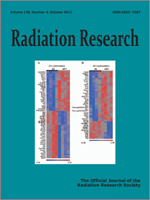Age at the time of exposure to sparsely ionizing radiation has been established as a key determinant of radiation cataractogenesis. However, while some reports suggest that the lenses of the young are hypersensitive, data from older studies are often conflicting and somewhat difficult to interpret when the radioresponse of young lenses is compared to that of adult lenses. Moreover, the mechanism of the age-response function for radiation cataractogenesis has yet to be identified. Since steroid sex hormones, notably estradiol, appear to play a role in age-related cataractogenesis, we hypothesized that the age response for radiation cataractogenesis could be dictated by estradiol status. We recently showed that exposure to high-linear energy transfer (LET) radiation resulted in a reduced latent period for, and enhanced progression of cataracts in rats that were 1 year old at the time of exposure compared to those that were 56 days old. However, the enhanced sensitivity of older lenses compared to younger lenses was independent of estradiol status. In the current study, we found that for 1-year-old rats exposed to 10 Gy of low-LET 60Co γ rays, the rate of increase in the development of posterior and anterior subcapsular cataracts was higher in older ovary-intact rats compared to young rats. However, cataracts were detected much earlier in ovary-intact 56-day-old rats compared to 1-year-old rats, regardless of their treatment groups (ovary-intact, ovariectomized, or ovariectomized and implanted with capsules containing estradiol). Thus, despite a consistent estradiol response (potentiating effect of estrogen) within a given age group, the differences between the radiation response of old and young lenses cannot be accounted for solely by estradiol status.
How to translate text using browser tools
10 August 2012
Age and Hormonal Status as Determinants of Cataractogenesis Induced by Ionizing Radiation. II. Sparsely Ionizing (Low-LET) Radiation
Joseph R. Dynlacht,
Shailaja Valluri,
Joy Garrett,
Jessica Nees,
Andrea Caperell-Grant,
Colleen DesRosiers,
Robert M. Bigsby
ACCESS THE FULL ARTICLE

Radiation Research
Vol. 178 • No. 4
October 2012
Vol. 178 • No. 4
October 2012




